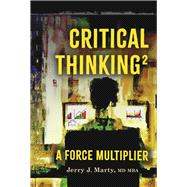Critical Thinking˛ - A Force Multiplier
, by Marty MD, MBA, Jerry J.- ISBN: 9798350938951 | 8350938951
- Cover: Hardcover
- Copyright: 4/11/2024
The Author provides a summary of the definition, principles, and challenges related to Critical Thinking2 - A Force Multiplier. In business and management, one faces many challenges, especially uncertainty, lack of information, unpredictability, and ambiguity. Problems that need systematic analysis will invariably arise. The fundamental proposition of this book is that "Critical Thinking2" lies at the interface of problem analysis and decision-making. Stepwise methodical problem analysis leads to decisive decision-making. This process precedes actual problem analysis and decision-making. Incisive comments about competence versus incompetence and the Dunning-Kruger effect ("If you don't know what you don't know," and the "confidence gap") are made in Chapter One, along with an in-depth discussion of intellectual curiosity, deliberation, and decision-making. Chapter Two covers the more common methodologies and techniques utilized in problem analysis, such as the Delphi technique; Strengths, Weaknesses, Opportunities, and Threats; the Cause and Effect (Fishbone or Ishikawa) diagram; Root Cause Analysis; Weighted Decision Matrix; Cost-Benefit Analysis; Breakeven Analysis; Probability Analysis; Sensitivity Analysis; Pareto Analysis; Analytic Hierarchy Process; Statistical Modeling (especially use of Linear Regression); Bayesian Analysis; Machine Learning; and Artificial Intelligence. An Introduction and overview to Statistics, especially the discussion of sample size, sample bias, statistical and practical significance, Linear Regression, the "Null" Hypothesis, the T-test, and F-test are discussed in Chapter Three. The distinction between "truths" and "facts," ending with an explanation of the contrasting correspondence and performance theories of "truth," is delved into in Chapter Four. The book emphasizes information, data, and "facts" as distinguished from "truth," but also examines misinformation, disinformation, and gaslighting. The Decision-Making process is an endpoint.






